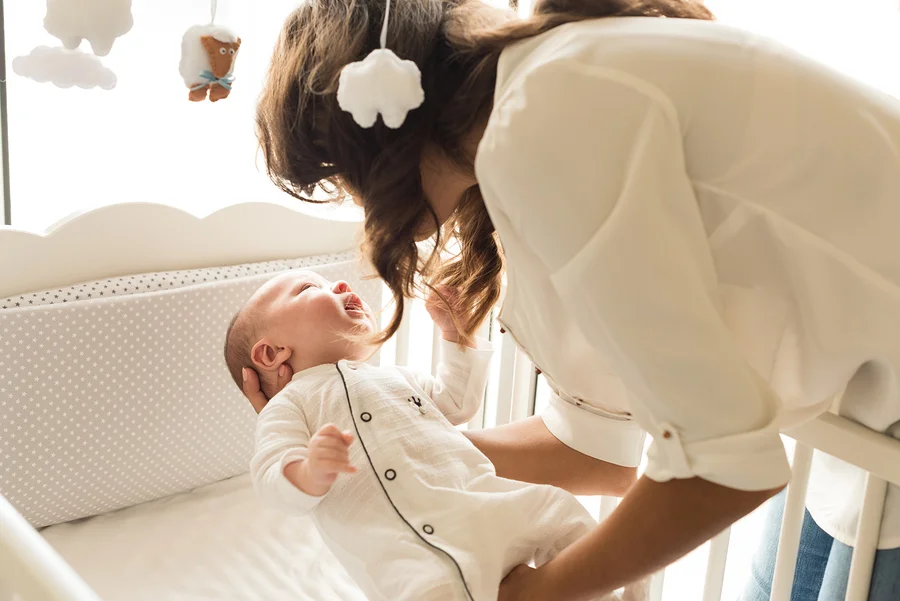Cranial Helmet Therapy: Inconvenient, Yes. Dreadful, No.
By Whitney Swance Starczewski
I am down on the bedroom floor, body flat, examining the top of my son’s head. My mind’s eye is dividing the top of Noah’s skull into four equal quadrants. “They look symmetrical enough to me”, I tell myself. I then shimmy over to his right side to get a profile view. From this angle, he sure doesn’t seem to have an abnormal head shape. I flip him over on his tummy; he giggles as my fingers softly graze the back of his head. Then, I take a deep breath as I acknowledge the writing on the wall. Flat. He’s got a flat head.
I reach over and pick up my cell phone; it’s laying lazily next to us, the screen displaying the results of my recent Google search. “How do I know if my child has a flat head?” is the question I had wanted answers to. Apparently, I wasn’t the first parent wanting to know; 370 million websites popped up, some with instructions on how to assess your baby’s skull shape, others on how to avoid Flat Head Syndrome, even more featuring baby photos reminiscent of the 90’s blockbuster Coneheads.
It seems silly now that I had to ask Google about my kid’s head shape; I could tell it was flat just by looking at it! But I was living in a state of denial. Maybe all babies have skulls like this, I thought to myself. At least for a while?...
Plagiocephaly, torticollis, brachiocepahly – medical lingo mingled with recommendations from pediatric physical therapists and seasoned parents. Increase tummy time. Avoid bouncers and swings. Keep the car seat in the car. Use baby carriers and slings. All of it seemed like sensible, doable advice – just keep your baby off their head, except when they’re sleeping, of course!
I never found it to be that easy though. First of all, Noah hated tummy time – and when I say hate, I mean screaming-bloody-murder, face-beet-red, make-himself-sick-to-his-stomach hate. It was ugly. But knowing how important it is for babies’ physical (and cognitive) development to spend time on their stomachs, and being reminded of this fact time and time again by his pediatrician, we made him do it anyway.
Every day, I would schedule several 10-minute slots of time when Noah would have to be on his tummy. I researched “how to make your baby like tummy time” and tried every single trick of the trade I could find. Nothing.worked. As a result, my son spent a lot of time on his back, his head leveling out little by little without us even noticing it. And after his pediatrician, orthopedic nurse practitioner, neurologist and two physical therapists confirmed my fledgling fear that the back of his head was flat, like really flat, I knew the much-maligned helmet would be an inevitable part of our near future.
Below I outline a few important realities associated with infant cranial helmets. I do so in hopes that they will allay your fears if you suspect your child may eventually need one. Noah’s had his on for a little over a month and I wish now that I could go back in time to tell my once-harried self that the “dreaded” helmet would not be nearly as bad as I thought. Expensive, potentially. Inconvenient, yes. Dreadful, no.
1.) They are expensive. If your child is uninsured, or your health insurance refuses to pay for it, a helmet could cost you something to the tune of $2,000-$3,000! That figure alone is panic-inducing, but in our case, Noah’s insurances were willing to pick up the entire cost. We did, however, have to jump through some hoops before they would agree to chip in. Not only did they ask for referrals from more than one specialist, both his primary and secondary insurances also required him to complete two months of physical therapy before they would pay up; they wanted to see if his skull would “correct” itself before they invested. Although in Noah’s case the therapy exercises didn’t end up fixing the back of his head, or improving his relationship to tummy time, they have helped him meet other physical milestones, like rolling over or sitting by himself. In other words, he would have needed the physical therapy anyway!
2.) Appointments, appointments, and more appointments. The myriad check-up appointments are the most annoying part of Noah having a helmet. After four visits with three different medical specialists, we were finally given the green light for him to be fitted by an orthotist. At his initial consultation, Orthotist Adam slid a nylon sock over Noah’s head which he then scanned to get his measurements. To my surprise, Noah didn’t it mind at all! Two weeks later, we went in to finally pick up the helmet. A week after that, we went in to ensure that it was fitting well, and two weeks after that, we went in again for Adam to re-size one side that was ever so slightly rubbing against Noah’s face. Monthly appointments will continue until the helmet is off. Along with his orthotist, Noah also sees an orthopedic nurse practitioner who monitors how his head is changing, not to mention the other ongoing medical appointments he has because of being born premature. Fortunately, I’m a stay-at-home mom for now, so keeping these appointments is not too much trouble. If I were working, however, this appointment schedule would be rigorous, not to mention extremely inconvenient.
3.) They get sweaty, dirty and stinky – the baby and the helmet. Much to our initial dismay, Noah had to begin wearing his helmet right at the start of summer. And, in order for the therapy to work, he’s required to wear it 23 hours/day, meaning it’s only allowed off during bath time and when it needs to be cleaned. The result is that by the end of most days, we have one sweaty, dirty, stinky baby (and helmet) on our hands. Fortunately, the fix is a simple one. We bathe Noah more often and we clean the helmet daily using a towel and water/alcohol spray. Pretty easy.
4.) The helmets are efficient. Noah’s only had his helmet on for a month, but it’s already made a huge difference! Ultimately, he will likely have to wear it for 4-5 months, this all depending, of course, on how fast his head grows. It seems long, but the time has flown! I can already tell that his noggin has rounded out significantly.
5.) The helmet becomes one with the baby. My greatest fears upon learning Noah needed a helmet was that he would hate it, that it would make him uncomfortable, that it would disrupt his well-established sleep routine and that he would become an angry, upset little boy as a result. When it came right down to it though, none of my anxieties came true. In fact, from the moment we put the helmet on him, he seemed to just accept it as if it were a new outgrowth of his head. The five-day initiation schedule certainly helped. For the first five days, he would wear the helmet for an hour or two, then have it off for the following hour. As the time went on, he came to wear the helmet for longer stretches of time until, ultimately, he was wearing it all day and all night. It didn’t even affect his sleep! Noah’s orthotist had told me babies don’t mind the helmets. Now I have living proof that it’s true!
No parent wants their child to end up with a flat head, especially one that needs fixing with a helmet, but sometimes, and especially in the age of “Back is Best”, it’s unavoidable. Despite our best efforts to push tummy time and keep him off his head, the flattening snuck up on us anyway. As a mom whose son wears a helmet, I can confirm for you that, no, they aren’t what you would call fun, but they’re also not the end of the world.
If you enjoyed this post take a moment to sign up for updates, announcements and chances to win giveaways from ispeakmom.com
© Nicola Rios Nogales and ispeakmom.com, 2018. Unauthorized use and/or duplication of this material without express and written permission from this blog’s author and/or owner is strictly prohibited. Excerpts and links may be used, provided that full and clear credit is given to Nicola Rios Nogales and ispeakmom.com with appropriate and specific direction to the original content.






